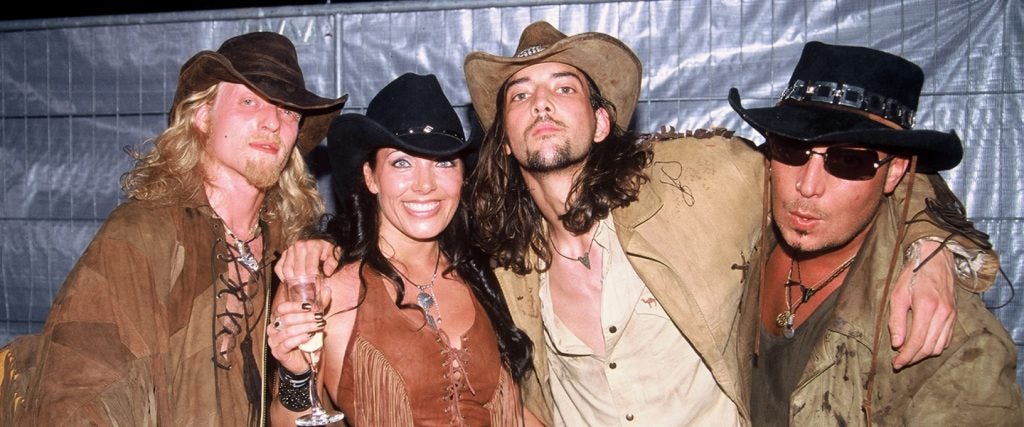The Rednex version of “Cotton Eye Joe” has existed my whole life — being released in 1994, the year I was born — and so, naturally, I’ve blindly accepted it as part and parcel of simply being alive. You dosey doe to “Cotton Eye Joe” at fancy dress parties, and that’s that; it’s one of the indisputable facts of life. But who is the mysterious, woman-stealing Joe? Where did he come from? And — importantly — where did he go?
Before it was a Swedish techno staple (yes, hyperbole), “Cotton Eye Joe” was a popular folk song among slaves in pre-Civil War America. According to American Songwriter, it was likely written between 1800 and 1860, and was typically played on a banjo or fiddle, with several variations of dances to go with it. The lyrics to the song were allegedly first published in Louise Clarke Pyrnelle’s 1882 novel, Diddie, Dumps and Tot, or Plantation Child-Life — and, while the main premise is the same, the verses are starkly different.
Where once — in the original — Joe stole just one man’s woman, in Rednex’s version, he seemingly has his way with all the women in the town. The folk version also contains language that couldn’t be sung by a group of white people from Sweden: “His eyes wuz crossed, an’ his nose wuz flat / An’ his teef wuz out, but wat uv dat?” The lyrics have evolved several times over the years, with Rednex’s including: “His eyes was his tools and his smile was his gun / But all he had come for was having some fun.”
The argument over whether “Cotton Eye Joe” is racist has been hotly debated for years. In 2015, The Huffington Post described the original lyrics as painting a “cringeworthy caricature,” and suggested that Joe could be the narrator’s slave. The latter suggestion is reportedly based on a lyric shared in an 1884 novel by folklorist Dorothy Scarborough, which reads: “He was de n*g dat sarved me so / Tuck my gal away fum me.” The racist slur and use of the word “sarved” — deemed to mean “served” in modern language — backs up the idea that the narrator is a slave owner.
The Huffington Post also theorized that the narrator could also be a slave himself, and is lamenting another slave stealing his girlfriend (“sarved” here could mean more like “served me right”). Some people have suggested that the mention of southern states and the word “cotton” — possibly referencing cotton plantations where slaves had to work — links the track to slavery, therefore making it racist. This argument seems to usually be made about the Rednex version, rather than the original folk song.
Much debate has also been had over what “Cotton Eye” actually means. As reported by Mental Floss, “cotton-eyed” — as the phrase was originally written — describes “prominent whites of the eyes”, with some suggesting that it details the contrast between white eyes and Black skin. Other theories purport that it means to be drunk on moonshine, blind from drinking wood alcohol or suffering from a medical condition that turns the eyes milky white or forces the eyeball to be replaced with a cotton ball. Another popular assumption is that the track is about STDs, and that Joe went around the town giving women various sexually-transmitted infections. The logic is that “Cotton Eye Joe” is “the act of a man having his urethra swapped by a Q-tip to test for STDs” — this doesn’t make sense for the original folk song, because STD testing didn’t exist, but, sure, Rednex could have meant that.
As for where “Cotton Eye Joe” went, he didn’t really go anywhere. The song has been regularly referenced in literature, including in Mark Twain’s Adventures of Huckleberry Finn, has had 134 different versions recorded since 1950, and, of course, has been immortalized by a Swedish band pretending to be Redneck Americans.
In fact, the latter — while it popularized the track for a new audience — drew criticism when it was released, as Americans allegedly found the Rednex’s use of stereotypes “deeply offensive.” Group member Pat Reiniz said at the time: “When we released ‘Cotton Eye Joe’, we knew very little about the American hillbilly and redneck culture, other than the stereotypes. For us, the redneck image was very compatible with the feeling of the music — raw, energetic, simple, party. It is only afterward that we have learned more about this culture, however.”
So, on his travels, Cotton Eye Joe managed to not only steal every girlfriend in the town — and possibly infect them with syphilis — but also offend nearly everyone who ever came across him. To be fair, the song’s lyrics do warn: “He brought disaster wherever he went.”
Anyway, thanks for coming, Cotton Eye Joe.

